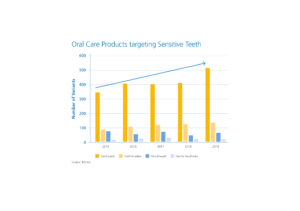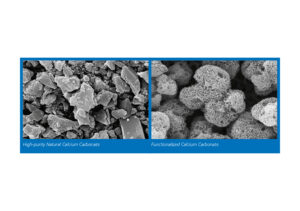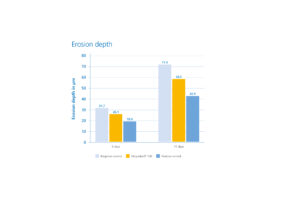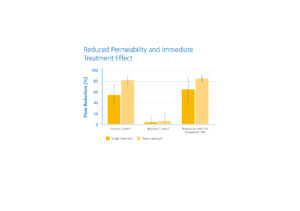Cosmetics & Personal Care
Responding to natural demand for healthy teeth 14th April 2021
Consumer demand for natural, sustainable and eco-friendly oral care products is at an all-time high, but so is the need for efficacy. Tanja Budde, head of innovation and technical marketing at Omya, explains how formulators can satisfy all of these requirements at the same time.
‘Vegan’, ‘organic’ and ‘sustainable’ are no longer claims that people just want to see on a carton of almond milk, a piece of fruit or a cup of coffee. These markers of natural wholesomeness are increasingly being sought out in personal care productstoo, including in toothpastes and mouthwashes. According to analysis of selected European markets by Mintel, 69% of consumers in Germany, Italy and Spain believe that oral care products should be more environmentally friendly, and 63% of consumers in France agree.
Presenting at The Healthy Bite International Forum on Oral Care Ingredients webinar held recently, Andrew McDougall, Global Associate Director for Beauty & Personal Care, Mintel Group, said the number one recommendation for brands at the moment is: “Meet natural demand”. Mintel global researchhas found that 63% of US oral care users have tried or are interested in trying natural oral care products; 58% of Vietnamese adults have replaced a regular product with a natural/organic version, and 60% of Chinese oral care users would choose a toothpaste with more natural ingredients, even if it had an unpleasant user experience.
Of course, an unpleasant user experience is not something that any company with an eye on success would want to deliver. And with today’s multifunctional natural oral care ingredients offering a range of benefits, including the ability to enhance a formulation’s texture and colour, it is something that never needs to happen.
Key concerns
As well as responding to consumer demand for more ethical and eco-friendly products, Mintel also suggests that manufacturers should target specific oral health concerns, including gum health. “Consumer awareness about gum health conditions seems to be high – an issue that increases in priority as consumers age,” says McDougall.
Mintel research shows that 68% of Spanish oral care users have tried to improve their gum health using oral care products/methods; 53% of US oral care users have tried or are interested in trying gum-detoxifying treatments, and 42% of UK adults who buy toothpaste say that gum health is a key consideration when making a purchase.
Gum disease is closely associated with dental hypersensitivity, an increasinglycommon condition that is being exacerbated by today’s lifestyle preference for tooth whitening procedures, as well as consumer consumption of fizzy drinks. Dental hypersensitivity is characterized by sharp, short pain that is triggered by certain stimuli. The most widely accepted theory (Brännström’s hydrodynamictheory) suggests that it is caused by the abrupt movement of fluid within the dentinal tubules in response to cold and heat (thermal), osmotic (eg eating sugary foods), mechanical (eg chewing) or evaporative stimuli (eg blasts of air). Toothpaste for sensitive teeth is now one of the fastest-growing categories. As can be seen inthe table below, the number of toothpaste launches for sensitive teeth has risen substantially since 2015, but there is still vast scope for mouthwash launches to target this sector too.
Formulation matters
 Formulating oral care products that respond effectively to current consumer requirements need not be difficult. As a specialist in natural calcium carbonate, Omya has spent many years researching and developing ingredients that can be used to create toothpastes, mouthwashes and other oral care products that tie inperfectly with today’s consumer needs. The company’s multifunctional ingredients are scientifically proven, sustainably produced, natural and suitable for vegetarian and vegan branding. Omyadent 100 and Omyadent 200 are two functionalized ingredients that have been developed to target the problems of dental hypersensitivity and enamel remineralization in particular.Both are based on a process of partial recrystallization to create new mineral compositions and structures with high porosity and novel functionalities.
Formulating oral care products that respond effectively to current consumer requirements need not be difficult. As a specialist in natural calcium carbonate, Omya has spent many years researching and developing ingredients that can be used to create toothpastes, mouthwashes and other oral care products that tie inperfectly with today’s consumer needs. The company’s multifunctional ingredients are scientifically proven, sustainably produced, natural and suitable for vegetarian and vegan branding. Omyadent 100 and Omyadent 200 are two functionalized ingredients that have been developed to target the problems of dental hypersensitivity and enamel remineralization in particular.Both are based on a process of partial recrystallization to create new mineral compositions and structures with high porosity and novel functionalities.
 The particles have a shell of hydroxyapatite – a calcium phosphate that is a major component of tooth enamel. This shell gives the ingredients exceptional affinity with the surface of the teeth, delivering better acid resistance for improved protection against acidic food and drinks.
The particles have a shell of hydroxyapatite – a calcium phosphate that is a major component of tooth enamel. This shell gives the ingredients exceptional affinity with the surface of the teeth, delivering better acid resistance for improved protection against acidic food and drinks.
 Figure 4 shows how surface lesions in tooth enamel can be repaired with Omyadent 100. Here, an enamel specimen treated with Omyadent 100 and 1450 ppm sodium monofluorophosphate has a smoother surface: defects have been repaired by a process of remineralization (images 1000x).
Figure 4 shows how surface lesions in tooth enamel can be repaired with Omyadent 100. Here, an enamel specimen treated with Omyadent 100 and 1450 ppm sodium monofluorophosphate has a smoother surface: defects have been repaired by a process of remineralization (images 1000x).
In a recent study, three groups of samples were subjected to a cycle of acid erosion and remineralization: Group A was a negative control (no toothpaste); group B was a positive control (market product based on patented technology, containing fluoride and other ingredients, and having an anti-erosion claim), while group C was treated with a test toothpaste containing 5% Omyadent 100, silica as the abrasive and no fluoride.
The samples were exposed to 0.6 % citric acid (pH circa 2.3) six times a day for 10 days, for two minutes each time, followed by rinsing with deionized water for one minute. After the first and last exposure, the samples were stored in the toothpaste slurry allocated to their group (one part toothpaste, two parts water) for six minutes. Subsequently, the samples were rinsed with deionized water for 30 seconds and stored in a remineralization solution of 1.98 mM CaCl2, 20.1 mM KCl, 11.9 mM NaHCO3, 4.09 mMH3PO4 (pH 6.7). The negative control samples were stored in the remineralization solution immediately after erosion and rinsing. All of the samples were kept in the remineralization solution overnight and analysis of the results showed that Groups B and C (market toothpaste and 5% Omyadent 100 toothpaste) had a marked anti-erosive effect on the tooth enamel.

Erosion depth after five days (26 μm) as well as after 10 days (58 μm)was significantly lower than in the negative control group, but slightly higher than in the positive control group (benchmark toothpaste containing fluoride).
Preventing sensitivity
 To target the growing issue of dental hypersensitivity, Omyadent 200 has been specially developed with small particles that effectively occlude exposed dentin tubules so that stimuli are unable to trigger dentinal fluid movement and pain. At the same time, the porosity of the ingredient means that the flow of nutrients within the tubules is maintained.
To target the growing issue of dental hypersensitivity, Omyadent 200 has been specially developed with small particles that effectively occlude exposed dentin tubules so that stimuli are unable to trigger dentinal fluid movement and pain. At the same time, the porosity of the ingredient means that the flow of nutrients within the tubules is maintained.
 Tubule morphologies in longitudinal sections have proven that Omyadent 200 effectively occludes dentinal tubules. As can be seen in Figure 7, the particles are not only located on the surface of a tubule, but also within them (Image A). Omyadent 200 particles as well as silica particles were identified up to a 9-micrometre depth inside the tubule (Image B), when a toothpaste formulated with Omyadent 200 was used.
Tubule morphologies in longitudinal sections have proven that Omyadent 200 effectively occludes dentinal tubules. As can be seen in Figure 7, the particles are not only located on the surface of a tubule, but also within them (Image A). Omyadent 200 particles as well as silica particles were identified up to a 9-micrometre depth inside the tubule (Image B), when a toothpaste formulated with Omyadent 200 was used.
Figure 8 shows SEM images of treated dentin specimens and the excellent tubule  occlusion properties of Omyadent 200 are clearly visible. Image 2 shows how the particles themselves occlude tubules effectively, and there is even greater occlusion in a toothpaste containing 5% Omyadent 200 (Image 3).Omyadent 200 also shows excellent tubule occlusion when compared to the benchmarked competitor toothpastes (Images 4-6). These were all products marketed for targeted treatmentof dentin hypersensitivity and based on different tubule occlusion mechanisms.
occlusion properties of Omyadent 200 are clearly visible. Image 2 shows how the particles themselves occlude tubules effectively, and there is even greater occlusion in a toothpaste containing 5% Omyadent 200 (Image 3).Omyadent 200 also shows excellent tubule occlusion when compared to the benchmarked competitor toothpastes (Images 4-6). These were all products marketed for targeted treatmentof dentin hypersensitivity and based on different tubule occlusion mechanisms.

In addition to morphology studies, Omyadent 200’s efficacy has been proven in a permeability (hydraulic conductance measurement) test, which showed that a single application of a silica toothpaste containing 5% Omyadent 200 effectively reduced permeability and indicated an immediate treatment effect. Triple treatment with the same toothpaste showed excellent flow reduction of 85% on average and thus excellent performance compared to a marketed toothpaste with a desensitization claim. In this study, a toothpaste marketed without a sensitivity claim was chosen as the negative control.
Tailored to specific needs
COSMOS approved and NATRUE certified, both Omyadent100 and Omyadent 200 comply with the most stringent regulatory and quality standards. Like all Omya products, they offer high chemical purity and controlled low microbiology.Furthermore, they are sustainably produced under clean and controlled manufacturing conditions for a reduced carbon footprint and minimum waste.The particles can be tailored to suit specific toothpaste, mouthwash and chewable mouthwash applications, all with pleasant taste and mouthfeel for high consumer acceptance. Omya’s application experts can offer advice and assistance on possible uses and formulations.
Further information
oralcare.omya.com
References:
Lightspeed/Mintel; KuRunData/Mintel: 35 market data Jul 2019. Base:US: 1,960 internet users aged 18+ who have used oral care products in the last 6 months; Vietnam: 1,000 internet users aged 18+; China: 3,000 internet users aged 20-49.
Lightspeed/Mintel France, Germany, Italy, Spain: 2,000 internet users aged 16+ in each country, 2019.
Lightspeed/Mintel: Spain: 1,975 internet users aged 16+ who have used oral care products in the last 3 months; US: 1,960 internet users aged 18+ who have used oral care products in the last 6 months; UK: 1,680 internet users aged 16+ who have bought a toothpaste in the last 3 months.



